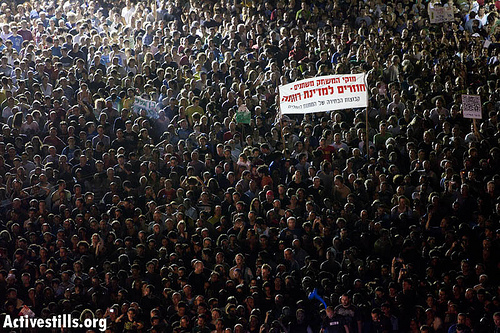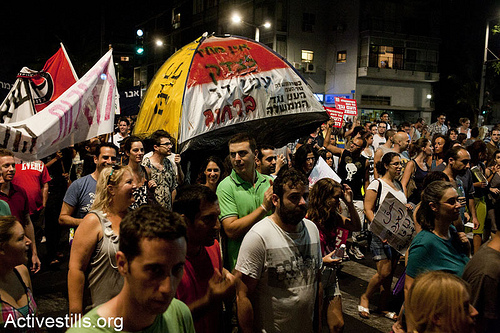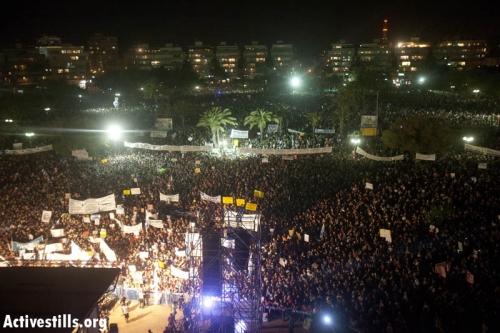J14 culminates into largest protest in Israeli history
- September 4, 2011
People & Protest
Half a million Israelis take to the streets in a historic protest against the high cost of living. The occupation, however, remains largely unaddressed.
- Author
After a two week lull in the seven week old Israeli protest movement, the J14 movement yesterday burst back onto the scene of Israeli politics, beating its own August record to hold the largest protest march in Israeli history. According to organizers, a total of 450.000 to 500.000 people partook in demonstrations across the country, with 300.000 gathering in Tel Aviv alone.
As Al Jazeera reported, “the grassroots movement has swollen since July from a cluster of student tent-squatters protesting against rising housing costs into a countrywide mobilisation of Israel’s middle class.” Protesters held banners saying “an entire generation wants a future!”, “get off your balconies, the country is collapsing!” and “Bibi, Bibi, go home!” As in previous demonstrations, chants demanding social justice were ubiquitous.
In the past two weeks the numbers of protesters camped out in the streets and squares had been declining, partly as a result of the end of summer holidays, with many going back to school, university and work, but also as a result of security diversions following clashes with Palestinians near the southern city of Eilat. Some have argued that the Netanyahu government tried to use the tensions along the Israel-Gaza border to draw attention away from the protests.
 Last night’s demonstration was proof, however, that the Israeli middle classes will no longer allow themselves to be distracted by petty security concerns. Writing for Haaretz, Gideon Levy praised last night’s mobilization as “a historic event,” while Nehemia Shtrasler optimistically wrote that “the balance of power has changed … the political discourse has changed,” and “Israel’s social unrest means the people are back on top.”
Last night’s demonstration was proof, however, that the Israeli middle classes will no longer allow themselves to be distracted by petty security concerns. Writing for Haaretz, Gideon Levy praised last night’s mobilization as “a historic event,” while Nehemia Shtrasler optimistically wrote that “the balance of power has changed … the political discourse has changed,” and “Israel’s social unrest means the people are back on top.”
The New York Times, in the meantime, reported that Daphne Leef, the 25-year old woman who pitched the first tent in Tel Aviv in mid-July and invited friends to join her on Facebook, told the crowd that the fact that her generation had stood up and raised its voice was “nothing short of a miracle — the miracle of the summer of 2011.”” Bradley Burston, editor at Haaretz and author of A Special Place in Hell, also lavishly praised the protest movement:
How can you tell if a revolution is real? When this all started, I had no idea. But I kept going to the tent camps and to the marches until I learned. It took just three words. An Arab Israeli, speaking to thousands of demonstrators two days after the recent terror killings near Eilat, said it all:
“Anachnu Am Echad.” We’re one people. In this society of tribal fractures and chronic rage, those three words were as radical and transformative and moral and direct a statement as any revolution could spawn. One people, Jew and Muslim and Christian and Druze, one people right and left, observant and secular, straight and gay, woman and man, infant and aged.
How can you tell a revolution is real? When it holds up a mirror that lets you see the back of your mind. In less than two months, this movement has changed the way people of all walks of life see each other, treat each other, and view their own lives. A week ago, our family marched in a demonstration behind a man who held up a sign reading “I’m a human being, Godammit. My life has value.”
How can you tell a revolution is real? When time after time, you suspect that no one will go to the demonstration this week, but you go anyway, because you believe that there is something vital in this, and its only when you get there that you realize that thousands and thousands and even hundreds of thousands of people were feeling the exact same thing.
In a culture which for decades has granted standout bullies management positions in government, business and unions, there is no act more radical than the phenomenon of people gathering to listen, actually stop and shut up and listen, to one another’s experience and opinions.
 Others, however, are more skeptical. Many human rights activists have noted that the J14 movement has stayed awkwardly silent on the greatest social justice issue of all: the Palestinian-Israeli conflict and the occupation of the Palestinian territories. +972 Magazine, whose coverage of the protests has been exceptional, was right to ask some critical questions in this regard. That said, some of the more critical issues did manage to seep through, especially in Haifa:
Others, however, are more skeptical. Many human rights activists have noted that the J14 movement has stayed awkwardly silent on the greatest social justice issue of all: the Palestinian-Israeli conflict and the occupation of the Palestinian territories. +972 Magazine, whose coverage of the protests has been exceptional, was right to ask some critical questions in this regard. That said, some of the more critical issues did manage to seep through, especially in Haifa:
The Haifa protest focused on the issue of discrimination against Arabs. Shahin Nasser, representative of the Wadi Nisnas protest tent in Haifa said: “Today we are changing the rules of the game. No more coexistence based on hummus and fava beans. What is happening here is true coexistence, when Arabs and Jews march together shoulder to shoulder calling for social justice and peace. We’ve had it. Bibi, go home. Steinitz, go and don’t come back, Atias, good-bye and good riddance,” he said, referring to the prime minister, the finance minister and the housing minister, respectively.
As Haaretz reported, even some high-ranking army officers are beginning to air support for the movement, slowly eroding the traditional ideological hegemony of the extremely conservative establishment surrounding the Netanyahu government and its oligopolistic cronies:
Col. (Res. ) Ze’ev Raz, who led the 1981 attack on the Iraqi nuclear reactor, forwarded to several people an e-mail from Lt. Col. (Res. ) Uri Shpirko, in which he lamented his economic situation given his military contribution, and after the old, familiar rhetoric, he wrote: “Two weeks ago, I was outside the Tel Aviv Museum with 100,000 demonstrators and I chanted with a dry throat, ‘the people demand social justice’ – and I tell you, the revolution has begun, big time. There were people there from east and west, from north and south, youngsters, older people, Jews and Arabs, religious and secular, Ashkenazim and Sephardim. The protest was so multifaceted that I fell victim to its charms.”
 Altogether, we should not get carried away by revolutionary rhetoric. As it stands, this is a protest movement — albeit a truly enormous one, encompassing one in eight Israelis — but not a revolutionary movement. The demands made are not for the “overthrow of the regime”, as in the Arab countries or in Greece, but rather for radical reform within the current structure. Few if any people seem to believe that the extant order can successfully be overthrown.
Altogether, we should not get carried away by revolutionary rhetoric. As it stands, this is a protest movement — albeit a truly enormous one, encompassing one in eight Israelis — but not a revolutionary movement. The demands made are not for the “overthrow of the regime”, as in the Arab countries or in Greece, but rather for radical reform within the current structure. Few if any people seem to believe that the extant order can successfully be overthrown.
Yet, as in Spain, it is very true that there is a certain transformative element to the protests — an element whose long-term impacts cannot be underestimated. This has to do with the conscientization of the masses of the grave injustices that are being perpetrated by those in power, and the gradual erosion of the discourse, ideology and legitimacy of the ruling classes that this conscientization implies. In a way, this is a struggle for cultural hegemony.
Public discussions, popular assemblies and shared struggles are the single most successful way to bring a divided people together against their common oppressors. As in Spain and Greece, what is happening in the squares of Tel Aviv is not a political revolution, but a revolution of the mind and the culture. This upliftment of the collective consciousness will undoubtedly help drive social change in the years and decades ahead.
 As Don Futterman wrote for +972 Magazine, the Israeli public has awoken after years of political alienation:
As Don Futterman wrote for +972 Magazine, the Israeli public has awoken after years of political alienation:
… if the members of the public get used to taking a longer, harder look at policy issues than can be summed up in a campaign slogan or name-calling, this could lead to a revolution in the Israeli psyche. Consider the unprecedented number of planned and spontaneous public education events taking place every day, with teach-ins at protest tents up and down the country, and competing forums at the same hour on different streets of Tel Aviv. Community activists, NGO advocates and socially committed academics who have been howling about the need to reboot our economic, housing, environmental and education priorities, suddenly have an audience ready to talk to into the night. Added to these are the public hearing websites, webcasts of events and interviews sharing face-to-face meetings with cyberspace, and innovative attempts to make reams of budget, planning and policy data available to the public on the internet in comprehensible and digestible formats.
Hopefully this newfound political engagement will help bring crucial human rights and social justice issues related to the conflict to light as well. As civil society reclaims the public space from the privatized realm of neoliberal government and the deregulated marketplace, a new platform for political debate is opened. Let’s hope that the decades-old taboo on progressive protest against the occupation will soon begin to fade as rapidly as Israeli political apathy did.
Source URL — https://roarmag.org/essays/j14-culminates-into-largest-protest-in-israeli-history/
Further reading
Neoliberalism, austerity and participatory democracy
- Sveinung Legard
- September 15, 2011
Joint statement from Puerta del Sol and Syntagma
- ROAR Collective
- September 4, 2011

